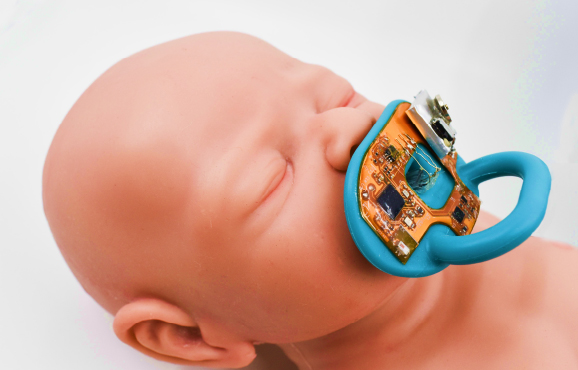
An international team of engineers has developed a wireless, bioelectronic pacifier that its designers say could eliminate the need for the invasive, twice-daily drawing of blood to monitor babies’ electrolytes in newborn intensive care units (NICUs).
The smart pacifier can provide relatively continuous monitoring of sodium and potassium ion levels, electrolytes that help alert caregivers to the possibility that babies are dehydrated, which is particularly dangerous for those born prematurely or with other health issues. When the smart pacifier was tested on a selection of infants in a hospital, the results were comparable to data gained from their normal blood draws.
‘We know that premature babies have a better chance of survival if they get a high quality of care in the first month of birth,’ said Jong-Hoon Kim, associate professor at the Washington State University School of Engineering and Computer Science. ‘Normally, in a hospital environment, they draw blood from the baby twice a day, so they just get two data points. This device is a non-invasive way to provide real-time monitoring of the electrolyte concentration of babies.’
Drawing blood can be potentially painful for the infant and leaves big gaps in information since they are usually done once in the morning and once in the evening. Other methods have been developed to use saliva tests to monitor the electrolytes, but they involve bulky, rigid devices that require a separate sample collection.
Using a common, commercially available pacifier, the researchers created a system that samples a baby’s saliva through microfluidic channels. Whenever the baby has the pacifier in its mouth, saliva is naturally attracted to these channels, so the device doesn’t require any kind of pumping system.
The channels have small sensors inside that measure the concentrations of sodium and potassium ion in the saliva. These data are then relayed wirelessly to the caregiver.
For the next step of development, the research team plans to make the components more affordable and recyclable. They will then work to set up a larger test of the pacifier to establish its efficacy.
According to Kim, development of the device forms part of a broader effort to make NICU treatment less disruptive for the tiny patients. ‘You often see NICU pictures where babies are hooked up to a bunch of wires to check their health conditions such as their heart rate, the respiratory rate, body temperature and blood pressure,’ said Kim. ‘We want to get rid of those wires.’
The research has been published in Biosensors and Bioelectronics.



